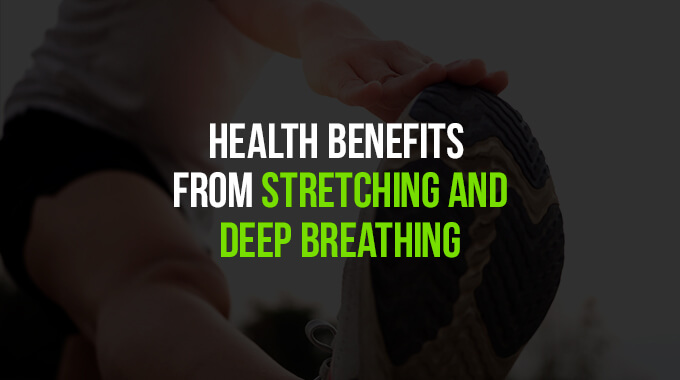
Subscribe to the Blog
Stay up to date
If you're not stretching or counting your breath throughout your workout, you're missing out on major health benefits. Whether you're a seasoned runner looking to hit a new PR or just starting out with fitness classes, your performance in the gym and recovery time after are hugely dependent on three fundamental elements of fitness — stretching, deep breathing, and core strength.
It's time to stop associating strength and endurance with total overall fitness. The reality is that without flexibility, diaphragm support, and appropriate timing, your level of fitness can easily and quickly deteriorate — and you may experience injury. Ultimately, stretching, deep breathing and core strength are the central contributors to mobility, stamina, mental discipline and focus, hormone function, and coordination.

The benefits of deep breathing and stretching exercises are too great to miss out on. This guide will show you how you can up your fitness game and improve your quality of life with simple and effective movements that will keep you in optimal shape for many years to come.
Stability and Balance
Have you ever taken a yoga class only to find out midway through that you can't stand on one foot without wavering, let alone land in a straddle split? While you may think that happens because of a lack of flexibility or inexperience, the real culprit is diminished stability.
When balancing, you're using your gross motor skills to maintain a controlled position or posture. From walking and running to bending down to pick something up, every physical activity is founded on your inherent ability to keep your balance. Regardless of your preferences in the gym, every exercise requires coordination and a strong sense of balance.
There are two types of balance — dynamic and static. While dynamic balance is staying in a position that requires movement, like squatting, running, and climbing a flight of stairs, static balance is your capacity to maintain a certain posture when performing stationary tasks, like standing, sitting, or performing certain yoga poses. Although you may be strong enough to curl 60 pounds at a time, you'd immediately fall over without your balance.
But there's more to balance than being able to lift weights or hold a pose. Here's how having good balance helps you in both your short-term fitness goals and long-term overall health:
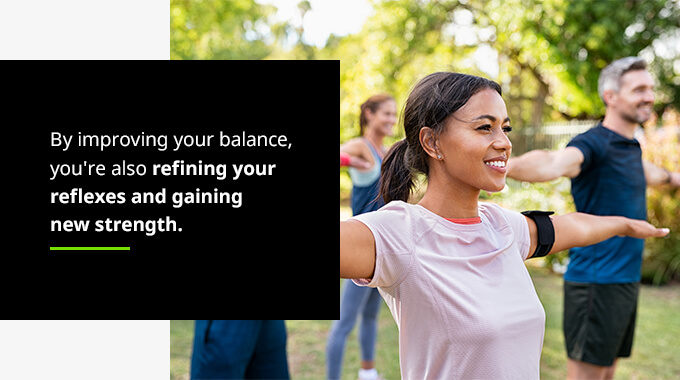
1. Improving Coordination and Strength
If you've ever played sports, you know that having proper hand-eye coordination is crucial. However, coordination is necessary for every aspect of life, whether you're on the field or in the office.
This is your ability to perform controlled motor responses in a smooth and accurate manner. It means that your body uses the right muscles with appropriate speed, timing, and direction to achieve the desired outcome, like catching a ball or stopping yourself from falling.
By improving your balance, you're also refining your reflexes and gaining new strength. These improvements help you perform better in every avenue of fitness, naturally strengthening your core and allowing you to easily adapt to new workouts and lifestyles.
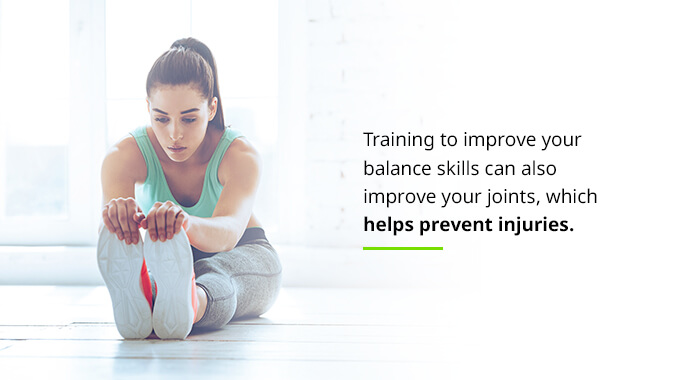
2. Preventing Injuries
There's nothing worse than suffering an injury at the peak of your fitness journey. Even the smallest sprain or tear can set you back for months, causing a loss of muscle, endurance, and strength.
It's common knowledge that good balance reduces the risk of falling, especially for seniors. But when it comes to strength and conditioning, studies have shown that poor stability will increase your risk of ankle and knee injuries compromise your overall form. Training to improve your balance skills can also improve your joints, which helps prevent injuries.
If you're new to the fitness world, aren't lifting heavy weights, or don't run long distances, sustaining an injury may not be your biggest concern. However, one of the biggest components of learning how to exercise as an adult is understanding body mechanics and the distribution of your own weight. While a movement may look simple, weight isn't always distributed evenly throughout the body and can easily throw off your balance.
While everyone hopes that they don't get injured inside or outside of the gym, strengthening your stability is a simple and effective way to ensure you don't have to worry about it.
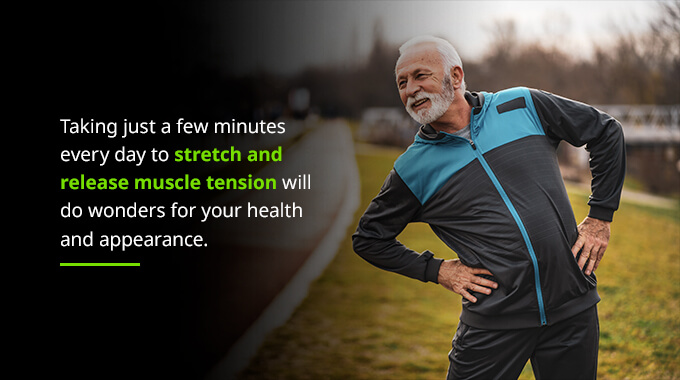
3. Refining Your Posture
How many times have you looked in the mirror and realized you were walking with your shoulders hunched over? While technology has contributed to many great advancements in the modern world, it's also a leading cause of poor posture. However, rounded shoulders, hunched backs, and downturned necks from gazing at smartphones are just the tip of the iceberg.
Slouching has been linked to chronic pain in areas of the body like the neck, back, and knees. It also causes circulation and digestive issues, heartburn, headaches, and strain on other joints and muscle groups that try to compensate for the crooked alignment.
The good news is that it's never too late to improve your posture. Taking just a few minutes every day to stretch and release muscle tension will do wonders for your health and appearance. Adding a daily stretching routine that strengthens your stability and builds greater balance will reverse the side effects of bad posture and strengthen your pelvic floor and inner core.
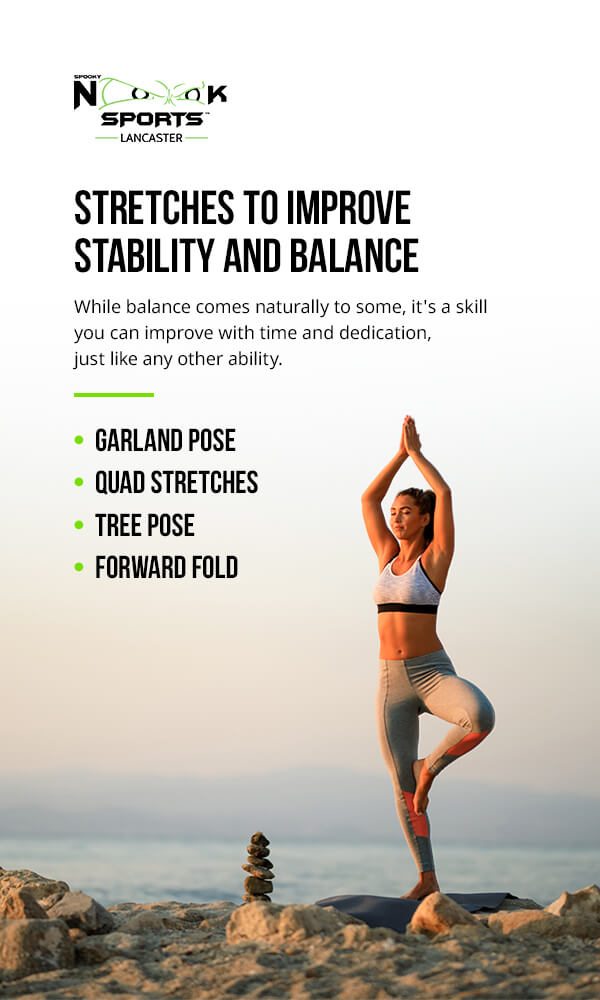
Stretches to Improve Stability and Balance
While balance comes naturally to some, it's a skill you can improve with time and dedication, just like any other ability. Here are five stretches that are proven to improve your posture and balance:
Garland Pose
- Step 1: Start by standing with your feet shoulder-width apart. Evenly distribute your weight between both feet while keeping them facing forward.
- Step 2: Bend your knees and allow your hips to sink down until your butt has reached the floor, or until you've hit the limit of your range of motion.
- Step 3: Place your arms between your knees so your elbows are bent and pressing against your knees.
- Step 4: Press the palms of your hands together in a prayer position and keep your chest lifted and facing forward.
This pose stretches your hips, thighs, groin, quads, ankles, and torso.
Quad Stretches
- Step 1:Start by standing with your feet hip-distance apart. Slowly bend one knee so your heel is driven back.
- Step 2:Try to bring your foot to your butt, using your hand from the same side to help deepen the stretch. If you have trouble balancing, try holding onto a chair for support.
- Step 3:Switch sides after 20 seconds and repeat.
This movement stretches your quad muscles and hip flexors.
Tree Pose
- Step 1: From a neutral standing position, lift and bend your left knee so that it points to the left and place your foot on the inner right thigh. Keep your hands on your hips until you've achieved balance.
- Step 2: Keep your hips facing front, so there's no rotation in the pelvis. Press your left foot and right thigh together to engage the soft-tissue muscles of your hip flexors.
- Step 3: For a more challenging variation, bring your hands together in a prayer position in front of your chest. After 20 seconds, release the pose and repeat on the other side.
This pose stretches your thighs, shoulders, thorax, and groin and strengthens your ankles, calves, thighs, and spine.
Forward Fold
- Step 1: Start by standing with your feet hip-distance apart. Breathe in, lengthening your spine and bringing your chest and shoulders into a neutral, lifted position.
- Step 2: As you breathe out, bend forward at your hips while keeping your knees soft and relaxed.
- Step 3: If you can't place your hands on the floor on either side of your feet, grab your calves with both hands and gently pull your torso closer to your thighs to deepen the stretch. Keep your weight on the balls of your feet and the top of your head parallel to the floor.
- Step 4: Breathe in again and slowly bring your chest up until you're back in a standing position. Use the strength in your legs to engage your hamstrings and roll your spine up until you're standing.
This position stretches your hips, hamstrings, and calves and strengthens your knees and quads.
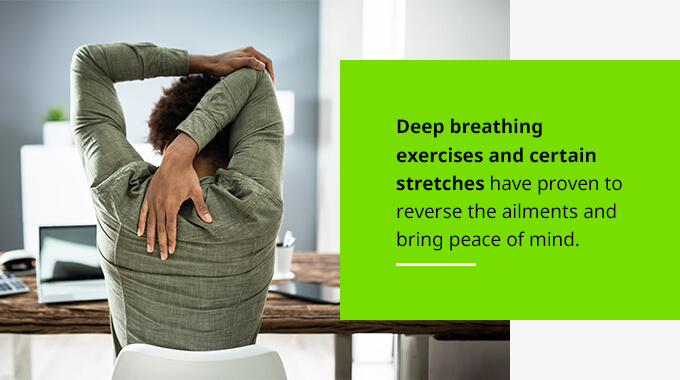
Fighting the Office Slump
If you've noticed changes in your posture after working a desk job, you're not alone — 47% of Americans are concerned about their posture and the lasting effects it has on their health and physical appearance. Unfortunately, even those who don't work in an office setting are also falling victim to the noticeable office slump.
The average American adult spends more than three and a half hours looking down at their phone every day, leading to worse posture and serious effects on your mental and physical health. Any time your body isn't in an optimally aligned position, it puts additional strain on your neck, back, and knees.
Slouching while you're sitting down comes with a laundry list of negative side effects, including joint pain, carpal tunnel, eye strain, chronic muscle pain, inflammation, and even increased risk of injury. If these conditions aren't enough to convince you to make changes, consider the physical symptoms that you can't see, like heartburn, digestive issues, headaches and migraines, high blood pressure, and a slower metabolism.
Research highlights that constant exposure to blue light and stimulating content via cellphones and computers has certain health impacts. From disruptions to the circadian system to increased headaches to poor mental health, there's reason to be concerned for your well-being in a world that's dominated by technology.
Fortunately, deep breathing exercises and certain stretches have proven to reverse these ailments and bring peace of mind.
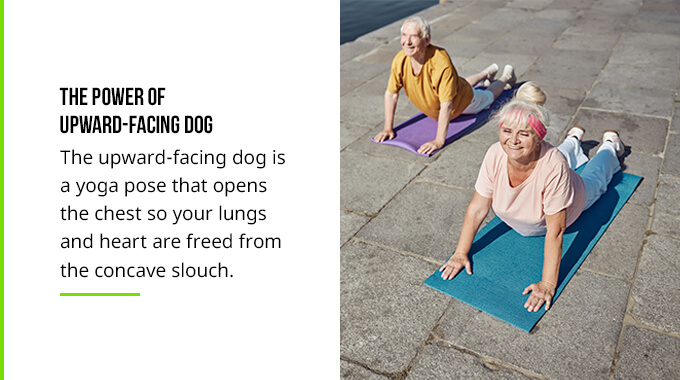
The Power of Upward-Facing Dog
The upward-facing dog is a yoga pose that opens the chest so your lungs and heart are freed from the concave slouch. It also strengthens your wrists and arms, which will provide additional support when typing and performing typical office tasks.
- Step 1: Start by lying flat on your stomach. Then, bend your elbows and place your hands on either side of your chest on the floor.
- Step 2: Bring your shoulder blades together and press your palms into the ground. Lift your torso off the floor, keeping your legs straight and engaged.
- Step 3: Breathe in and lift your torso even more while raising your hips and thighs off the floor. Keep your arms and legs straight with your head tilted back slightly. The only points of contact with the floor should be your hands and the tops of your feet.
Put Your Legs Up
If you suffer from anxiety, depression, headaches, or insomnia, you can enjoy mental health benefits from stretching in this position.
All you have to do is lay on your back and swing your legs up against the wall. Press your hips up against the wall or just a few inches away from it. Laying in this position for just 20 minutes a day will bring a noticeable difference to your mental and physical health, especially after a long and stressful day at work.
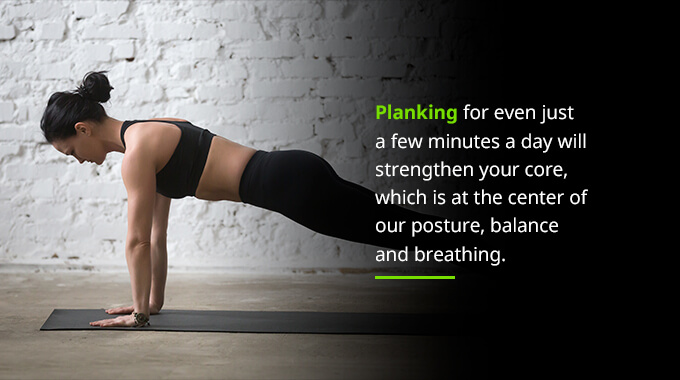
Planking and Bridging
If you've noticed your hips have been in pain or your knees are giving out more often, it's time to build the muscle around those weakened joints. In fact, many knee-related injuries are the result of weak muscles around the glutes, hips, and quads. If you're experiencing pain and other issues in these areas, planking and bridging are the perfect movements to add to your daily routine.
There are many great benefits from plank exercises — planking for even just a few minutes a day will strengthen your core, which is at the center of our posture, balance, and breathing. Other plank exercise benefits include strengthening your arms, legs, and glutes while building greater mental focus and resilience. Additionally, the bridge pose addresses the same problem areas, plus your hamstrings, chest, neck, and spine.
How to Plank
Although it may look like a relatively easy exercise, planking is one of the most difficult positions to hold. It requires you to engage your inner core muscles while keeping your arms, legs, and glutes strong. When done correctly, a plank should be immovable.
Unfortunately, many people don't know how to correctly hold this pose and end up with their spines misaligned and their rears either raised too high or dipped too low. These errors can cause further strain on your spine and neck. To get the most health benefits of doing plank exercises, here's the right way to get into position:
- Step 1: Start by getting into a push-up position. Place your hands directly under your shoulders, or slightly wider than shoulder-width, with your arms extended straight.
- Step 2: Plant your toes into the floor and squeeze your glutes and legs to stabilize the hold.
- Step 3: Keep your neck, shoulders, and spine in a straight line. Focus your gaze on a spot on the floor that's about 12 inches in front of your hands.
- Step 4: Hold this position for 15 seconds, then release. Repeat three times, extending the holding time as you build strength. Remember to breathe throughout the hold.
Learning to Bridge
Once you've mastered the plank and worked on your other stretches, you can try your hand at bridging. If you suffer from lower back pain or a curved spine from prolonged sitting, a bridge pose provides relief by counteracting abnormal spine curvature. Plus, you get the benefits of gently stretching your abs, chest, and shoulders while building strength in your glutes, back, ankles, and thighs.
Here's how you can ease yourself into bridge pose:
- Step 1: Start by lying on your back, keeping your knees bent and feet flat on the floor. Keep your arms flat and pressed against the floor on either side of your torso.
- Step 2: Push your arms and feet into the floor. As you breathe out, lift your hips off the floor towards the ceiling.
- Step 3: Keep your glutes relaxed and draw your tailbone in as you create a neutral position for your hips.
- Step 4: Maintain contact between the floor and your shoulders with your thighs and feet parallel to the floor.
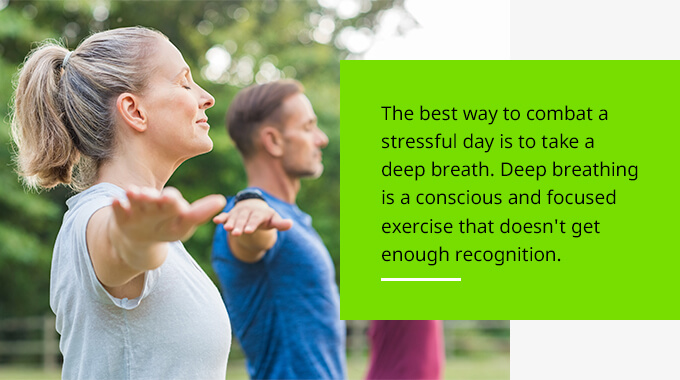
The Power of Breath: Release Tension in Your Mind and Body
Many of us hold stress in our bodies without even realizing it. However, there are small telltale signs you're holding a considerable amount of stress that may seem like normal ticks and tendencies.
Sometimes it's small changes in your stance, like your shoulders shrugging closer to your ears or clenching your jaw shut. Some people exhibit their stress through excessive movements, like tapping their feet under the table or feeling the urge to walk around the room. From sporadic mood swings and forgetfulness to sleep disorders and fatigue, we often ignore the body's natural signals that tell us to slow down and release built-up tension.
The best way to combat a stressful day is to take a deep breath. And while that may sound simple, deep breathing is a conscious and focused exercise that doesn't get enough recognition. At the center of every yoga class, lift, run and stretch is the art of breathing. When you hear powerlifters groaning with each rep, or tennis players grunting when they hit a ball, it's for a good reason — every breath has a purpose, whether you're running laps or practicing martial arts.
Each movement is given more power, stability, speed, and accuracy. But there are so many other advantages to learning how to breathe deeply. Other health benefits of deep breathing exercises include:
- Lowering blood pressure
- Improving digestion
- Reducing stress
- Improving circulation
- Improving sleep quality
- Reducing fatigue and increasing energy
- Releasing muscle tension
- Balancing blood sugar levels
- Gaining more control over emotional responses
- Fostering confidence and peace of mind
No matter where you currently are, you can enjoy the benefits of deep breathing. Simply sit in a comfortable position. Then, inhale slowly through your nose and hold your breath for about two seconds. Finally, slowly exhale through your mouth. Repeat this process as many times as you wish until you feel calmer.
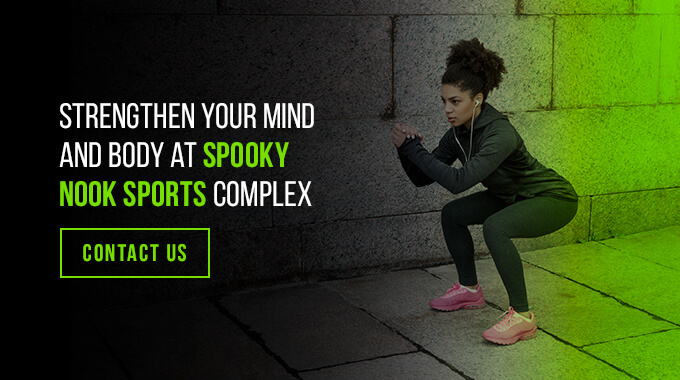
Strengthen Your Mind and Body at Spooky Nook Sports Complex
Both stretching and breathing are just the first steps towards creating a well-balanced lifestyle. While small changes to your daily routine, like including these stretches, can jumpstart your journey to a better and healthier you, long-term results require consistency and dedication. That's where we come in.
Spooky Nook Sport's MIND/BODY classes are designed to empower you throughout your fitness journey and help you achieve new inner and physical strength. With our team of expert fitness instructors to guide you along the way, our dynamic group fitness classes will engage your body and mind.
With programs like BodyFlowTM and Yoga, we'll help you reach your fitness goals and create a lifestyle that supports positive habits. At Spooky Nook, we'll show you how to improve your mental focus and naturally increase your energy levels, so you can perform better at work and take control of your mental health.
Here, our goal is to create an environment that allows you to reach your full potential, so you can live a healthier life with a better mindset. With incredible amenities like state-of-the-art locker rooms and certified nutritionists, we have everything you need to tackle your goals head-on.
Contact us today to schedule a tour or to find out more about our group fitness classes!










